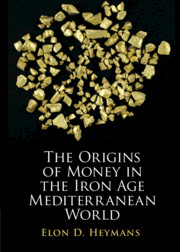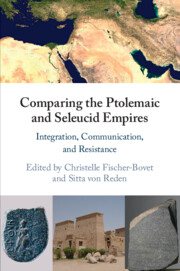Refine search
Actions for selected content:
23990 results in Ancient history
Part III - Ethnicity and Identity in the Roman Empire
-
- Book:
- Rome: An Empire of Many Nations
- Published online:
- 04 August 2021
- Print publication:
- 23 September 2021, pp 167-272
-
- Chapter
- Export citation
13 - Local Identities of Synagogue Communities in the Roman Empire
- from Part III - Ethnicity and Identity in the Roman Empire
-
-
- Book:
- Rome: An Empire of Many Nations
- Published online:
- 04 August 2021
- Print publication:
- 23 September 2021, pp 223-238
-
- Chapter
- Export citation

The Origins of Money in the Iron Age Mediterranean World
-
- Published online:
- 17 September 2021
- Print publication:
- 26 August 2021

Comparing the Ptolemaic and Seleucid Empires
- Integration, Communication, and Resistance
-
- Published online:
- 17 September 2021
- Print publication:
- 30 September 2021
Chapter 8 - Minerva, Venus, and Cicero’s Judgments on Caesar’s Style
-
- Book:
- The Politics and Poetics of Cicero's <I>Brutus</I>
- Published online:
- 28 October 2021
- Print publication:
- 16 September 2021, pp 217-243
-
- Chapter
- Export citation
Preface and Acknowledgments
-
- Book:
- The Politics and Poetics of Cicero's <I>Brutus</I>
- Published online:
- 28 October 2021
- Print publication:
- 16 September 2021, pp ix-xi
-
- Chapter
- Export citation
A Note on the Text
-
- Book:
- The Politics and Poetics of Cicero's <I>Brutus</I>
- Published online:
- 28 October 2021
- Print publication:
- 16 September 2021, pp xii-xii
-
- Chapter
- Export citation
Chapter 3 - Caesar and the Political Crisis
-
- Book:
- The Politics and Poetics of Cicero's <I>Brutus</I>
- Published online:
- 28 October 2021
- Print publication:
- 16 September 2021, pp 75-101
-
- Chapter
- Export citation
Glossary
-
- Book:
- Diodoros of Sicily: <I>Bibliotheke Historike</I>
- Print publication:
- 16 September 2021, pp 266-270
-
- Chapter
- Export citation
Preface
-
- Book:
- Diodoros of Sicily: <I>Bibliotheke Historike</I>
- Print publication:
- 16 September 2021, pp ix-x
-
- Chapter
- Export citation
Chapter 2 - The Intellectual Genealogy of the Brutus
-
- Book:
- The Politics and Poetics of Cicero's <I>Brutus</I>
- Published online:
- 28 October 2021
- Print publication:
- 16 September 2021, pp 44-74
-
- Chapter
- Export citation
Index Locorum
-
- Book:
- The Politics and Poetics of Cicero's <I>Brutus</I>
- Published online:
- 28 October 2021
- Print publication:
- 16 September 2021, pp 288-290
-
- Chapter
- Export citation
Chapter 5 - Beginning (and) Literary History
-
- Book:
- The Politics and Poetics of Cicero's <I>Brutus</I>
- Published online:
- 28 October 2021
- Print publication:
- 16 September 2021, pp 135-164
-
- Chapter
- Export citation
Copyright page
-
- Book:
- The Politics and Poetics of Cicero's <I>Brutus</I>
- Published online:
- 28 October 2021
- Print publication:
- 16 September 2021, pp iv-iv
-
- Chapter
- Export citation
Index
-
- Book:
- Diodoros of Sicily: <I>Bibliotheke Historike</I>
- Print publication:
- 16 September 2021, pp 278-310
-
- Chapter
- Export citation
Chapter 1 - Ciceropaideia
-
- Book:
- The Politics and Poetics of Cicero's <I>Brutus</I>
- Published online:
- 28 October 2021
- Print publication:
- 16 September 2021, pp 20-43
-
- Chapter
- Export citation
Dedication
-
- Book:
- The Politics and Poetics of Cicero's <I>Brutus</I>
- Published online:
- 28 October 2021
- Print publication:
- 16 September 2021, pp v-vi
-
- Chapter
- Export citation
Introduction
-
- Book:
- The Politics and Poetics of Cicero's <I>Brutus</I>
- Published online:
- 28 October 2021
- Print publication:
- 16 September 2021, pp 1-19
-
- Chapter
- Export citation
Maps
-
- Book:
- Diodoros of Sicily: <I>Bibliotheke Historike</I>
- Print publication:
- 16 September 2021, pp xiii-xxiv
-
- Chapter
- Export citation
Contents
-
- Book:
- Diodoros of Sicily: <I>Bibliotheke Historike</I>
- Print publication:
- 16 September 2021, pp vii-vii
-
- Chapter
- Export citation
